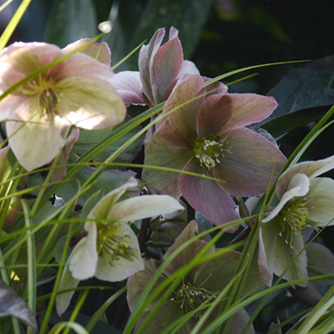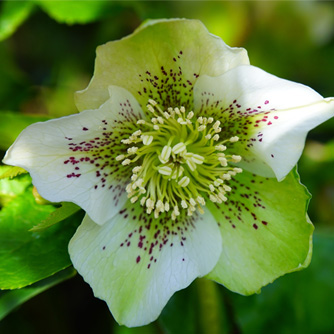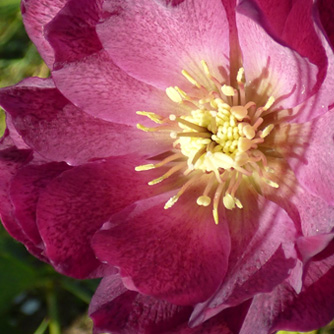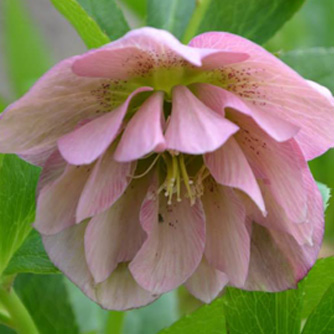Hellebores
BackHellebores are cool climate perennials that brighten up dull winter days with their lovely display of long lasting elegant, nodding flowers. They’re available in a range of flower colours with recent breeding adding semi and double flowers in very trendy colours such as slate grey, nearly black, deep purple and plum.
Hellebores are commonly called the ‘Winter Rose’ and they’re ideal for cottage gardens, herbaceous borders or planted en mass underneath deciduous trees. While their flowers bring winter colour don’t overlook their distinctive foliage which contrasts nicely when planted with silver or purple foliage plants.
How To Grow Hellebores
Hellebores are versatile, frost resistant plants but there are a few key things they don’t like: wet feet, high humidity, sandy soils and being thirsty in their first summer. Their ideal conditions are rich soil with good drainage, shade in summer and sun or good light in winter. The clumping varieties (Helleborus x hybridus) are the most tolerant of humidity and are usually the type you’ll see in regular nurseries.

Cluster of antique coloured hellebore flowers
Improve poor soils before planting by digging in plenty of organic material eg old manure and compost. If dealing with heavy clay apply gypsum to improve drainage. After planting mulch with sugar cane or straw mulch and water in a combination of OCP eco-aminogro and OCP eco-seaweed to get the plants off to a great start. Ensure adequate watering for the first 12 months especially during summer.
Plants grown in warm dry climates usually adapt after a few years and can become quite drought tolerant. Just make sure they have plenty of sun protection during summer.
Hellebores need to be 2-3 years old before they’ll flower so be patient if starting with a young plant.
Fertilising & Maintenance of Hellebores
The growth period for hellebores starts in autumn and early winter when they will produce new foliage and flower stems. So this is the perfect time to clean up plants by removing all the old foliage and stems right down to the ground. By now the old leaves will be looking pretty tired anyway and their removal makes way for the fresh new growth.

White hellebore flower with freckles
Feeding should also be done at this time to support all the new growth. Firstly apply a certified organic pelletised fertiliser or aged manure and then a dose of dolomite. The eco-flo dolomite will provide calcium and magnesium for healthy plants.
With the non-clumping varieties (these tend to be species hellebores which are taller growing) cut off the finished flower stems in spring. With clumping varieties (usually the lower growing hybrid varieties) you can leave the flower stems on for many months and the petals will age and change colour. Prune off whenever you like or keep them until the big autumn clean up.
The clumping hellebores can be divided in autumn if the mass is getting too congested. They have fairly extensive roots so dig deep to minimise root disturbance. The non-clumping species instead produce lots of seedlings which can be moved in winter. In both cases water in divided or transplanted plants with OCP eco-seaweed to reduce the shock and encourage new roots.

Burgundy hellebore flower
Pests and Diseases of Hellebores
Hellebores are relatively free of pests and diseases except for a couple of common problems such as:
- Aphids – these sap suckers can be easily controlled with a spray of OCP eco-oil or OCP eco-neem. Spray at the first sign of aphids and ensure good coverage for the best results.
- Powdery mildew – this fungal disease appears as a white or grey coating over foliage and stems and can be control with an organic fungicide. To reduce repeat infections increase air circulation around the plant and avoid wetting leaves when watering. Regular applications of OCP eco-seaweed and OCP eco-aminogro will also build strong healthy plants with more disease resistance.
- Snails - sometimes snails will take a liking to the foliage but can be controlled with a sprinkling of OCP eco-shield pellets.
Note – all parts of this plant are poisonous.

Soft pink double hellebore flower


